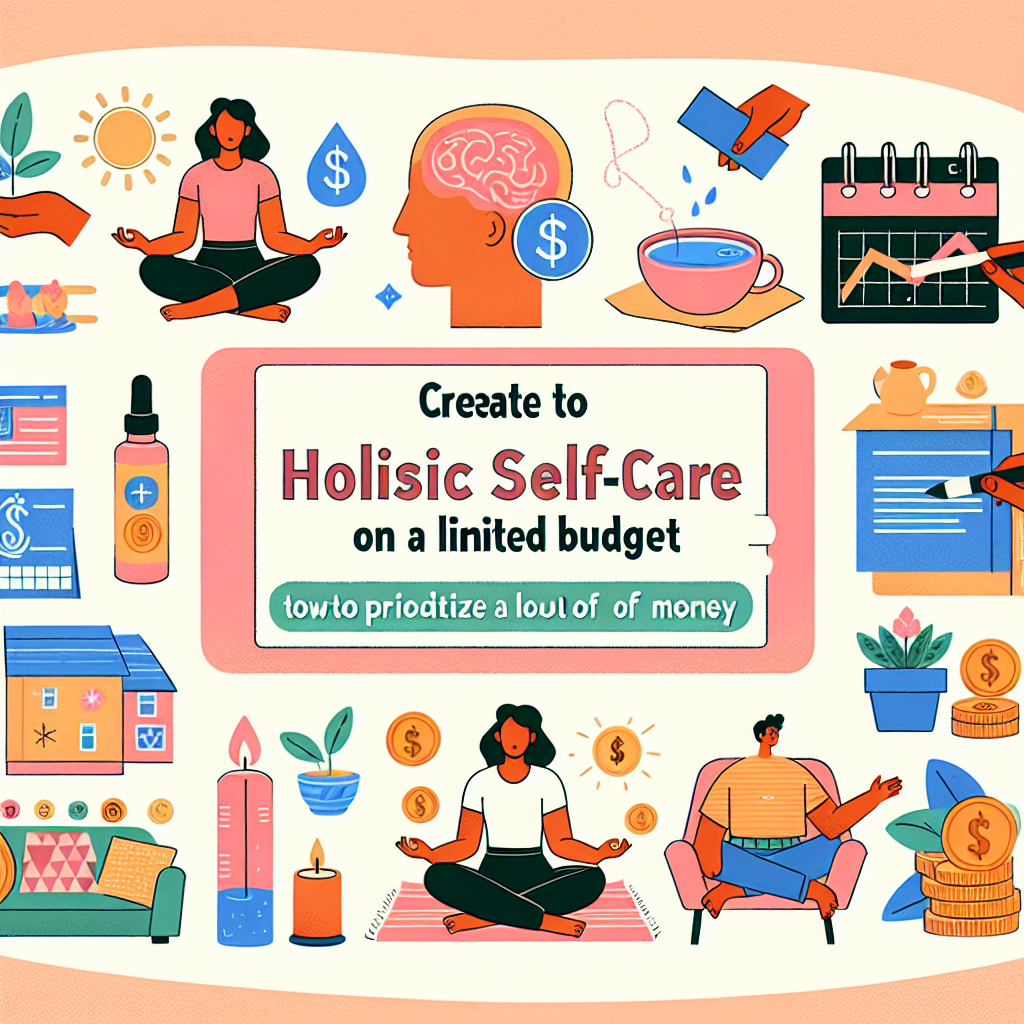In today’s fast-paced world, taking care of ourselves both physically and mentally is of utmost importance. However, the notion of practicing holistic self-care often comes accompanied by the fear of breaking the bank. But fear not! There are plenty of affordable ways to prioritize your well-being and embrace a holistic approach to self-care without putting a strain on your wallet. From simple lifestyle changes to budget-friendly activities, this article will guide you on your journey towards practicing holistic self-care while keeping your finances in check.

Creating a Budget-Friendly Self-Care Routine
Taking care of yourself shouldn’t have to break the bank. By creating a budget-friendly self-care routine, you can prioritize your mental, physical, and emotional well-being without putting a strain on your finances. Here are some tips to help you get started on your journey to holistic self-care without breaking the bank.
Setting Realistic Goals
One of the first steps in creating a budget-friendly self-care routine is to set realistic goals. Think about what areas of your life you want to focus on and what activities or practices align with those goals. By setting clear and attainable objectives, you can ensure that your self-care routine is both effective and budget-friendly.
Identifying Free or Low-Cost Activities
Self-care doesn’t have to be expensive. There are plenty of free or low-cost activities that you can incorporate into your routine. From taking walks in nature to practicing yoga at home using online tutorials, there are numerous options that won’t strain your wallet. Identifying these activities will help you find joy and relaxation without overspending.
Utilizing Online Resources
The internet is a treasure trove of resources when it comes to self-care on a budget. You can find free guided meditations, workout routines, and even virtual therapy sessions. Take advantage of these online resources to enhance your self-care routine without spending a dime. Look for reputable websites, apps, and social media accounts that provide valuable information and support.
Creating a Self-Care Schedule
To ensure consistency in your self-care routine and avoid burnout, it’s helpful to create a schedule. Designate specific times in your week for self-care activities and stick to them. By intentionally carving out time for yourself, you can prioritize your well-being and make sure it doesn’t get pushed aside in the busyness of everyday life.
Prioritizing Mental Well-being
Taking care of your mental health is essential, and you don’t need to spend a fortune to do so. Here are some budget-friendly practices you can incorporate into your self-care routine to prioritize your mental well-being.
Practicing Mindfulness and Meditation
Mindfulness and meditation are powerful tools for reducing stress and improving overall mental well-being. You don’t need any special equipment or a fancy meditation studio to practice these techniques. Simply find a quiet and comfortable space, set a timer, and focus on your breath or a calming mantra. There are numerous free meditation apps and YouTube channels that offer guided meditations to help you get started.
Engaging in Creative Outlets
Expressing yourself creatively is another excellent way to nurture your mental well-being. Engage in activities such as painting, writing, or playing a musical instrument. These creative outlets can provide a healthy emotional outlet, stimulate your imagination, and offer a sense of accomplishment. Look for low-cost or free art supplies, writing prompts, or online tutorials to spark your creativity.
Finding Supportive Communities
Connecting with like-minded individuals can be incredibly beneficial for your mental health. Seek out supportive communities that share your interests or struggles. Whether it’s joining an online forum, participating in virtual support groups, or attending local meetups, surrounding yourself with a supportive network of people can provide a sense of belonging and emotional support without costing a fortune.
Exploring Self-Help Books
Self-help books are an affordable way to gain valuable insights and tools for personal growth. Visit your local library or look for free or low-cost e-books. There is an abundance of self-help literature on various topics, including mindfulness, emotional intelligence, and stress management. Reading these books can provide you with new perspectives and practical strategies for improving your mental well-being.
Nurturing Physical Health on a Budget
Taking care of your physical health doesn’t have to be expensive. There are many budget-friendly ways to prioritize your well-being and boost your energy levels. Here are some tips to help you nurture your physical health without breaking the bank.
Embracing Regular Exercise
Regular exercise is crucial for maintaining good physical health, and it doesn’t have to cost a fortune. Instead of expensive gym memberships, consider free or low-cost activities like walking, jogging, or cycling in your neighborhood or local park. You can also find free workout routines and yoga classes online. By incorporating exercise into your self-care routine, you can improve your overall well-being without spending a dime.
Preparing Healthy and Affordable Meals
Eating well is an essential part of self-care. However, it’s a common misconception that healthy meals are costly. With some planning and creativity, you can prepare nutritious and budget-friendly meals at home. Look for seasonal produce, buy in bulk, and explore recipes that use affordable ingredients. Cooking at home not only saves money but also allows you to have control over the quality and nutritional value of your meals.
Discovering Affordable Wellness Apps
Technology can be a valuable tool for maintaining your physical well-being on a budget. There are numerous wellness apps available that offer free or low-cost features such as workout routines, nutrition trackers, and sleep aids. Take advantage of these apps to stay motivated, track your progress, and receive guidance in your self-care journey.
Exploring Natural Remedies
Instead of relying solely on expensive medications or treatments, consider exploring natural remedies for common health concerns. For example, herbal teas can provide relaxation and aid digestion, essential oils can be used for aromatherapy, and cold compresses can soothe muscle soreness. Research natural remedies for your specific needs and try incorporating them into your self-care routine.
Cultivating Emotional Resilience Without Splurging
Cultivating emotional resilience is vital for managing stress and enhancing overall well-being. Here are some budget-friendly practices you can incorporate into your self-care routine to nurture emotional resilience.
Practicing Emotional Release
Emotional release techniques, such as deep breathing exercises, crying, or venting in a journal, can help process and release pent-up emotions. These practices can be done anywhere, anytime, and they don’t cost a thing. By regularly allowing yourself to express and release your emotions, you can improve your emotional well-being and find inner peace.
Journaling and Self-Reflection
Journaling is a powerful self-care tool that allows you to process your thoughts and emotions. It provides an outlet for self-expression, self-reflection, and personal growth. Take a few minutes each day to write down your thoughts, feelings, and experiences. This practice can help you gain insight into your emotions, identify patterns, and release any negative energy.
Engaging in Positive Affirmations
Positive affirmations are simple yet powerful statements that can change your mindset and boost your confidence. Repeat phrases such as “I am capable,” “I am enough,” or “I am worthy” to yourself daily. You can write them down, recite them in front of a mirror, or record them as voice memos. Engaging in positive affirmations regularly can help rewire your thoughts and cultivate a more positive and resilient mindset.
Connecting with Loved Ones
Building and maintaining healthy relationships is an important aspect of emotional well-being. Connect and spend quality time with your loved ones, whether it’s through phone calls, video chats, or making plans for budget-friendly activities together. Sharing your thoughts and feelings with trusted friends or family members can provide emotional support and strengthen your resilience.

Developing a Mind-Body Connection
The mind-body connection is a crucial aspect of holistic self-care. By nurturing this connection, you can enhance your overall well-being. Here are some budget-friendly practices to help you develop a strong mind-body connection.
Exploring Alternative Therapies
There are several alternative therapies that can help foster a mind-body connection without costing a fortune. Practices such as acupuncture, acupressure, and reflexology can help alleviate stress, balance energy, and promote relaxation. Look for affordable options, such as community clinics or discounted packages offered by local practitioners.
Trying Yoga or Tai Chi
Yoga and Tai Chi are ancient practices that combine movement, breath control, and mindfulness. They are excellent ways to improve flexibility, balance, and mental clarity. Many communities offer low-cost or donation-based classes, and there are also numerous free yoga and Tai Chi videos available online. Incorporating these practices into your self-care routine can greatly enhance your mind-body connection.
Implementing Breathing Exercises
Deep breathing exercises are a simple and effective way to connect your mind and body. Whether it’s diaphragmatic breathing, box breathing, or alternate nostril breathing, these techniques can help calm your nervous system, reduce anxiety, and promote relaxation. Practice these exercises regularly, and you’ll notice a shift in your mind-body connection.
Taking Relaxing Baths
A warm and soothing bath can do wonders for your mind and body. Add some Epsom salts, essential oils, or bath bombs to enhance the experience. Create a tranquil atmosphere by lighting candles or playing calming music. Taking the time to relax in a bath can help relieve muscle tension, reduce stress, and promote a sense of calm without costing a fortune.
Harnessing the Power of Nature
Nature has a profound impact on our overall well-being. Spending time in nature, gardening, and connecting with animals are all budget-friendly ways to reap the benefits of the natural world. Here’s how you can harness the power of nature in your self-care routine.
Spending Time Outdoors
Spending time outdoors is a simple and effective way to improve your well-being without spending a dime. Whether it’s going for a hike, having a picnic in the park, or simply sitting under a tree, being in nature can reduce stress, increase creativity, and improve mood. Take regular breaks from your daily routine to soak in the beauty of the natural world around you.
Gardening on a Budget
Gardening is a wonderful way to connect with nature and nurture your mental and physical well-being. You don’t need a large space or expensive tools to start a garden. Utilize containers, window boxes, or community garden plots if you don’t have access to a yard. Grow your own herbs, vegetables, or flowers and enjoy the therapeutic benefits of tending to your garden on a budget.
Forest Bathing and Nature Walks
Forest bathing, also known as Shinrin-yoku, is a practice that involves immersing yourself in nature and mindfully connecting with the natural environment. Take leisurely walks in local parks, forests, or nature reserves to experience the therapeutic benefits of being surrounded by greenery. This practice can reduce stress, boost immunity, and enhance overall well-being.
Connecting with Animals
Animals have a unique ability to provide companionship, affection, and emotional support. If you don’t have a pet, consider volunteering at an animal shelter or spending time with friends or family members who have pets. Even observing wildlife, such as birds or squirrels, can help you connect with nature and experience the joy and peace it brings.
Building Healthy Relationships on a Shoestring Budget
Having healthy relationships is an essential part of self-care. Here are some budget-friendly practices that can help you build and maintain meaningful connections with others.
Setting Boundaries and Saying No
Setting healthy boundaries is crucial for maintaining healthy relationships. Learn to say no when something doesn’t align with your needs or values. Prioritize your well-being and communicate your boundaries to others respectfully. This practice can help you create supportive relationships based on mutual respect and understanding.
Investing Time and Effort
Building strong relationships requires time and effort, but it doesn’t have to be expensive. Instead of expensive outings or gifts, focus on spending quality time with your loved ones. Plan budget-friendly activities such as cooking together, going for walks, or having a game night at home. By investing time and effort in your relationships, you can strengthen your connections without breaking the bank.
Engaging in Meaningful Conversations
Meaningful conversations are the backbone of healthy relationships. Take the time to truly listen to others and share your thoughts and feelings openly. Engage in deep and thoughtful discussions that strengthen your bonds. Spending quality time with loved ones and having meaningful conversations can create a sense of connection, understanding, and emotional support.
Planning Budget-Friendly Dates
Dating doesn’t have to be expensive. Get creative with your date ideas and plan activities that align with your budget. Instead of fancy restaurants, consider having a picnic in the park or cooking a meal together at home. Explore free or low-cost local attractions, such as museums, art galleries, or hiking trails. By planning budget-friendly dates, you can nurture your relationships without breaking the bank.
Exploring Holistic Self-Care Practices
Holistic self-care encompasses various practices that nurture your mind, body, and spirit. Here are some holistic self-care practices you can try without breaking the bank.
Trying Acupressure or Reflexology
Acupressure and reflexology are practices that involve applying pressure to specific points on the body to promote relaxation and balance in the body’s energy systems. You can learn basic acupressure and reflexology techniques through online tutorials or books. These practices can help relieve stress, alleviate pain, and improve overall well-being.
Engaging in Sound Therapy
Sound therapy, also known as sound healing, uses sound vibrations as a tool for relaxation and healing. You can explore this practice by listening to calming music, playing musical instruments, or using singing bowls or tuning forks. Experiment with different sounds and frequencies to find what resonates with you and promotes a sense of peace and tranquility.
Experimenting with Aromatherapy
Aromatherapy uses essential oils to enhance psychological and physical well-being. Incorporate essential oils into your self-care routine by diffusing them at home, adding a few drops to a bath or massage oil, or creating a homemade room spray. Research the different properties and benefits of essential oils to find those that align with your specific needs.
Practicing Reiki or Energy Healing
Reiki is a Japanese practice that involves the transfer of healing energy through the practitioner’s hands to promote physical and emotional well-being. While it’s beneficial to receive Reiki from a trained practitioner, you can also learn self-Reiki techniques to perform on yourself. Another form of energy healing you can explore is practicing visualization or meditation techniques that focus on balancing and clearing your energy centers, or chakras.
Utilizing Apps and Online Resources
In today’s digital age, there is an abundance of apps and online resources that can support your self-care journey. Here are some ways you can utilize these tools without spending a fortune.
Finding Free or Affordable Meditation Apps
Meditation apps are a popular resource for enhancing mindfulness and relaxation. Many apps offer free versions or affordable subscription plans that provide access to guided meditations, sleep aids, and stress reduction programs. Explore different meditation apps to find one that aligns with your preferences and budget.
Exploring Self-Care YouTube Channels
YouTube is a great platform for finding free self-care resources. Many content creators offer guided meditations, yoga classes, workout routines, and mental health tips. Subscribe to channels that resonate with you and make use of their free content to support your self-care routine without breaking the bank.
Accessing Virtual Therapy and Counseling
Professional therapy and counseling can be expensive, but virtual options provide accessible and affordable alternatives. Look for websites or apps that offer virtual therapy sessions or counseling at reduced rates. These platforms connect you with licensed professionals who can provide support, guidance, and tools to enhance your mental and emotional well-being.
Joining Online Support Groups
Online support groups provide a sense of community and connection, especially for individuals facing specific challenges, such as mental health conditions or chronic illnesses. Look for free or low-cost online support groups relevant to your needs. These groups can offer a safe space to share experiences, gain insights, and find support from like-minded individuals.
Maintaining Consistency and Accountability
Maintaining consistency and accountability is essential for a successful self-care routine. Here are some tips to help you stay motivated and on track without spending a fortune.
Tracking Progress and Celebrating Achievements
Track your progress and celebrate your achievements along the way. Whether it’s journaling, keeping a habit tracker, or creating a vision board, find a method that works for you. By visually witnessing your progress and celebrating milestones, you’ll stay motivated and inspired to continue your self-care journey.
Finding an Accountability Partner
Having an accountability partner can significantly improve your consistency and motivation. Find someone who shares similar goals or interests and check in with each other regularly. Share your successes, challenges, and lessons learned. This support system can provide encouragement, guidance, and motivation to maintain your self-care routine.
Rewarding Yourself in Budget-Friendly Ways
Rewarding yourself for your accomplishments doesn’t have to involve expensive treats or splurges. Find budget-friendly ways to celebrate your progress, such as treating yourself to a bubble bath, enjoying a movie night at home, or indulging in a favorite hobby. By acknowledging and celebrating your achievements, you’ll continue to stay motivated and committed to your self-care routine.
Learning from Setbacks
Setbacks are a natural part of any self-care journey. Instead of viewing them as failures, see them as opportunities for learning and growth. Reflect on what caused the setback, analyze what you can do differently next time, and make adjustments to your self-care routine as needed. Embrace setbacks as valuable lessons that will help you further develop your resilience and commitment to self-care.
In conclusion, practicing holistic self-care doesn’t have to break the bank. By setting realistic goals, identifying free or low-cost activities, utilizing online resources, and creating a self-care schedule, you can establish a budget-friendly routine. From prioritizing mental well-being to nurturing physical health, cultivating emotional resilience, and developing a mind-body connection, there are numerous practices you can explore without overspending. By harnessing the power of nature, building healthy relationships, exploring holistic self-care practices, utilizing apps and online resources, and maintaining consistency and accountability, you can create a comprehensive and budget-friendly self-care routine that prioritizes your overall well-being. Remember, self-care is not a luxury reserved for the wealthy, but a fundamental necessity for everyone, including you. So go ahead, give yourself the care and love you deserve, without breaking the bank.

